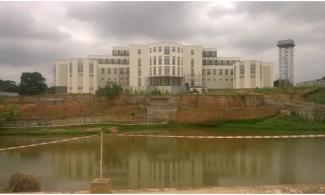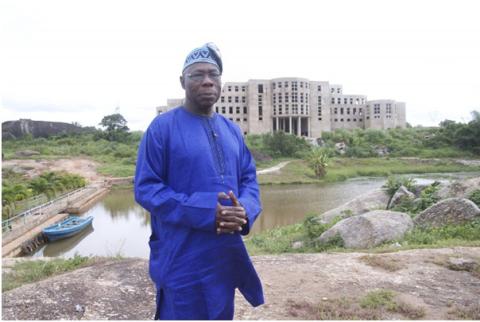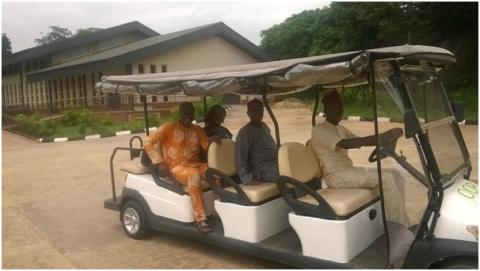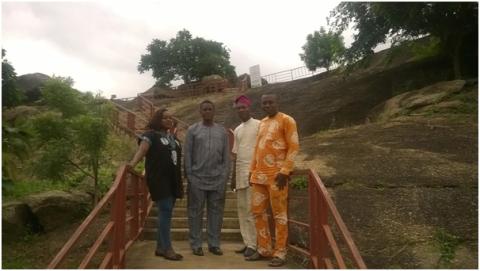
The first of its kind in Nigeria and probably Africa, OOPL continues the distinguished tradition where the nation’s President bequeaths historical documentation of his life’s achievements to the. As in other parts of the world, the Olusegun Obasanjo Presidential Library provides an accommodation for the life’s work and memorabilia on the Obasanjo Presidential years as well as a commission to carry out research work on him and other matters of interest.
My phone shivered in my pocket. It was my friend, Ayo Aderinwale returning a call I had made earlier in the day. Over the years, Ayo and I have come a long way as collaborators of many political and literary projects. For about 25 years, he was the Executive Director of the African Leadership Forum (ALF), Ota, a leading International Organisation in the areas of Leadership advocacy and training. Having worked closely with Ayo in ALF for many years, I was not surprised when the hard working and erudite intellectual was recently pushed upstairs by his boss, the irrepressible former President Olusegun Obasanjo as the Deputy Chief Coordinator of the Olusegun Obasanjo Presidential Library (OOPL), Abeokuta.

Afterwards, in his usually boisterous manner, Ayo chided me for not coming over to Abeokuta to see his new place of work. As a writer and cultural buff, I didn’t need to be prodded before visiting such an historic place after having previously visited many of such edifices around the world. And so, I had to ask my friend for forgiveness for my oversight. Finally, one Friday morning, after a series of postponements due to my usually congested schedule, I was able to free myself for a visit to Abeokuta.
As I drove into Abeokuta, the mid day sun seemed to hover over the town’s newfound modernity; the impressive wide boulevards and flyovers overshadowed its ancient and cultural toga.
At Oke-Mosan, we turned at the NNPC Mega Station and entered what seemed like a vast Housing estate. The Obasanjo Library Complex was ringed by a scenic mountain and green vegetation giving it a perfect mix of scenery and culture. As if by design, the first building in the complex is the Chapel of Christ Glorious King where, the Lord of the Manor himself, Chief Olusegun Obasanjo, a postgraduate student of Divinity is said to be a sunday school teacher.
The first of its kind in Nigeria and probably Africa, OOPL continues the distinguished tradition where the nation’s President bequeaths historical documentation of his life’s achievements to the. As in other parts of the world, the Olusegun Obasanjo Presidential Library provides an accommodation for the life’s work and memorabilia on the Obasanjo Presidential years as well as a commission to carry out research work on him and other matters of interest.
Established in 2005 the Presidential Library was fashioned parallel to the United States’ Presidential Library system and culture. As the first on the African Continent, the Presidential Library is expected to promote Nigeria on the world stage and inspire other African nations in the advancement of democracy and preservation of the past for the benefit of the future. According to the Library’s official brochure; ‘’At a more local level the Library will teach children and young adults the essential concepts of leadership and citizenship through the example of a former president. By upholding the critical worth of good governance, the exhibitions should inspire future leaders of Nigeria.”

On the Library’s aims and objectives the brochure states; ‘’the OOPL aims at ‘preserving the past, capturing the present and inspiring the future’. It is a historic, touristic, recreational and academic centre, which is regarded as a national archive and a place for the preservation of presidential documents and historical items associated with the office and person of President Olusegun Obasanjo. It will house some cultural artefacts and feature essential events in the Nigerian history and modern African history’.”
After the usual pleasantries, my host, the DCC, assigned me a tour guide as well as a shuttle driver to take me round the edifice which he promised will be ready for use by the end of the year. And comfortably ensconced in a six-seater shuttle cart, I was taken round the Library Complex, a massive construction site full of artisans, library workers, and a smattering of visitors.
Commencing from the Youth Centre, a three story building at the posterior end of the complex, my tour of the OOPL took me up hills and valleys, benches, lakes and through parks that had postcard worthy views.
‘Apart from various forms of relaxation, young people will be exposed to various forms of formal and informal training workshops,’ our Tour Guide said of the Youth Centre. From here, we proceeded to the Wild Life Park, which, according to the Tour Guide, would be filled with exotic animals such as Lions, Elephants, Hyena among others. ‘’And for our visitors who will want a true taste of African cuisine, our Bamboo Grove is the place to go,’’ the tour guide said as she pointed out a big lush bamboo clearing with neatly arranged chairs and tables where waiters and waitresses could be seen serving food and drinks. Nearby, a clear and gentle stream snaked its way down the slope giving the grove, a place of wonderful aroma and vibrant colours, a highly romantic setting.
‘’If you want to catch a bird’s eye view of Abeokuta, you have go to the highest point in the complex, the Rock of Inspiration,’ said our guide. Since the shuttle cart could not ascend the very rocky and sharp incline, we had to make our way up to the ‘Rock Of Inspiration’ using wooden steps. It was a long climb which almost left me breathless. As could be gleaned from red crosses and other inscriptions on the rock’s face, the rocky spot must have been used previously as a prayer mountain. We had an awesome view of Abeokuta from the mountain top, a view that our guide promised would be better once the much expected telescope was installed.

A little higher above our heads we could see the three story Main Library still under construction. Its location at the mountain peak, gave the greyish building an ecclesial aura all the more grandeur with a beautiful man-made lake in its front. ‘’The building has been designed like an outstretched arm welcoming visitors,’’ our tour guide said. We were further informed that when fully commissioned, the Library will be stocked with books and educational material from all over the world. We were also told that the penthouse on top of the Library has been designed as the private residence of the Library’s Chief Coordinator, a statement that left our small group of visitors in deep thoughts!
We descended the mountain to visit a massive stone and mortar hangar that accommodated some Presidential artefacts such as OBJ’s first car, a well-kept Volkswagen Beetle car, one official car, a jeep, a military helicopter and a miniature warship.
The scene reminded me of my visit to the Ronald Reagan Memorial Presidential Library in Los Angeles, California two years earlier. The Reagan Library which is the largest of the thirteen federally operated presidential libraries in the US is Located at 40 Presidential Drive, Simi Valley, Los Angeles. The Library is numbered in honour of Reagan's place as the 40th US President. The facility is an expansive facility which houses the former President’s Mausoleum, the Library, an old Air Force One Plane as well as his official Chopper and Armoured car. And just like the OOPL, the RRMPL was also located on top of a hill with a great view of the Simi Valley and Los Angeles.
However, unlike the RRMPL and the Kwame Nkrumah Presidential Library which I also visited in Accra, Ghana a few years ago, some of OBJ’s personal materials used during his Presidential career such as brief case, writing table, reading glasses, pen, agbada and caps are missing in the OOPL. And since Reagan’s famous bottle of Jelly Beans was also in his Library, it is hoped that OBJ’s famed Kolanuts will also be included in the OOPL. In addition, OBJ’s mausoleum (at a ripe old age) should also be sited in the Library Complex.
Our next visit was the 4-star Green Legacy Resort, the hotel facility that is already commissioned and functioning. According to the company’s official brochure, ‘’the Resort is an eclectic blend of the modern harmonizing grandeur, offering style and comfort in which guests and tourists can enjoy the serenity of the Resort without feeling removed from the vibrancy and pulse of Nature.”
I was told that the Green Legacy Resort has over 100 rooms with facilities such as elevated swimming pools (Main & Children pool), a tennis court, a modern well-designed gym, amusement park, sauna among other facilities.
Other facilities in the complex that are already functioning are the Auditorium, Amphitheatre, and the Adire and African Fabrics Centre where I purchased some mementoes and some good quality adire tops. And just opposite to the church is another functioning facility, the Children’s Playground. This is a high rise mechanical contraption of automated circular steel and plastic seats which will certainly send children into whoops of joy and excitement.
Despite the reported controversy that trailed the launch of the OOPL, many years ago, the novel idea of establishing Presidential Libraries formally began in 1939, when President Franklin Roosevelt of the US donated his personal and Presidential papers to the Federal Government. At the same time, Roosevelt pledged part of his estate at Hyde Park to the United States, and friends of the President formed a non-profit corporation to raise funds for the construction of the library and museum building.
Roosevelt's decision stemmed from a firm belief that Presidential papers are an important part of the national heritage and should be accessible to the public. He asked the National Archives to take custody of his papers and other historical materials to administer his library. Before the advent of the Presidential Library system, Presidents or their heirs often dispersed Presidential papers at the end of the administration. Though many pre-Hoover collections now reside in the Library of Congress, others are split among other libraries, historical societies, and private collections. Sadly, many materials have been lost or deliberately destroyed. In 1955, the US Congress passed the Presidential Libraries Act, establishing a system of privately erected and federally maintained libraries. The Act encouraged other Presidents to donate their historical materials to the government and ensured the preservation of Presidential papers and their availability to the American people.
Under this and subsequent acts, more libraries have been established. In each case, funds from private and non-federal public sources provided the funds to build the library. Once completed, the private organization turned over the libraries to the National Archives and Records Administration to operate and maintain.
The Presidential Records Act of 1978 established that the Presidential records that document the constitutional, statutory, and ceremonial duties of the President are the property of the United States Government. After the President leaves office, the Archivist of the United States assumes custody of the records. The Act allowed for the continuation of Presidential libraries as the repository for Presidential records. The Presidential Libraries Act of 1986 also made significant changes to Presidential libraries, requiring private endowments linked to the size of the facility. NARA uses these endowments to offset a portion of the maintenance costs for the library.
From the above, it is hoped that the Nigeria’s National Assembly will also enact appropriate legislations regarding Presidential Libraries in the country.
Back in the DCC’s office after my tour, Ayo Aderinwale was very upbeat about the OOPL. With a gleaming smile and an infectious optimism, Aderinwale said; ‘’our plan is to turn every inch of the Library Complex into a repository of knowledge. Every item from wildlife to the trees and rocks will be labelled and classified as a form of Library without walls for our visitors.”
As I later took my leave of OOPL and Abeokuta, it was obvious that a new scene was emerging in the city; in art, literature, fashion and culture. Apart from the famous Olumo rock and the adire fabric, the Ake Literary Festival, a great ensemble of international and local writers has now become an annual event and another tourist delight in the rocky city. Now a world class Library has been added to boot! And being the hometown of a Nobel Laureate in Literature, Abeokuta will soon be playing host to the rest of the world. A fleeting stopover can no longer do it justice, Abeokuta has plenty to say and it’s worth staying to listen.
Wale Okediran, an award winning author is a former National President, Association of Nigerian Authors and a former Member, House Of Representatives, Abuja, Nigeria.
